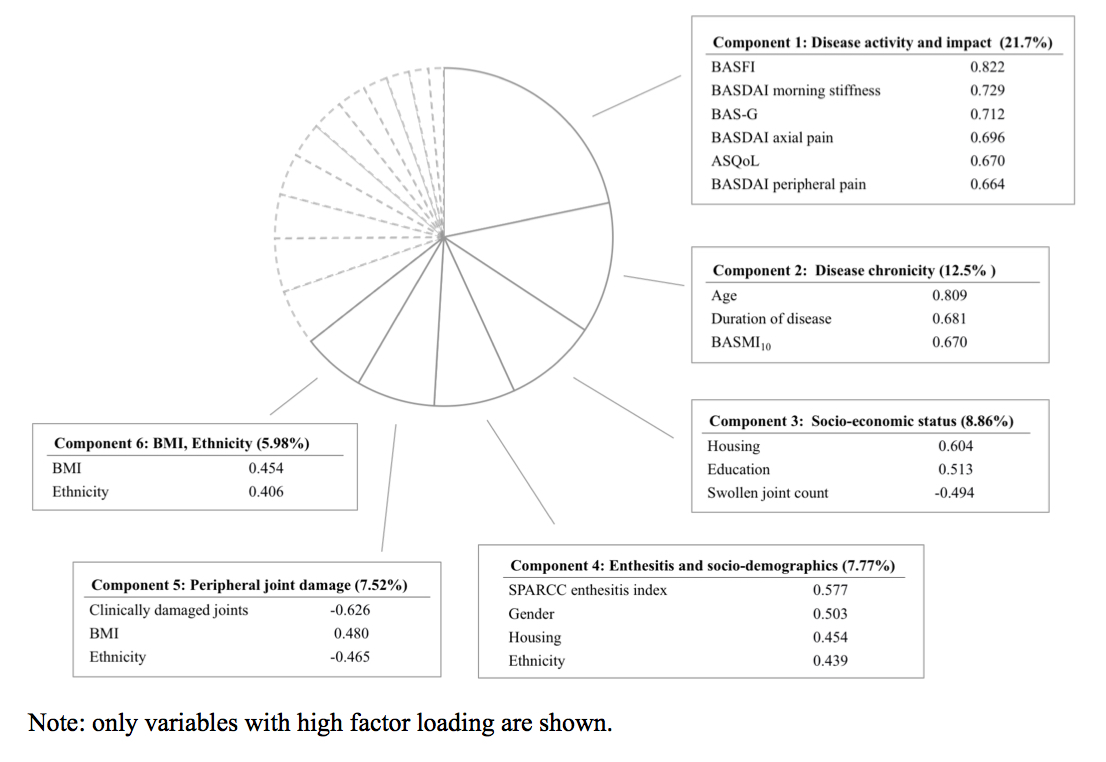Session Information
Date: Sunday, November 8, 2020
Session Type: Poster Session C
Session Time: 9:00AM-11:00AM
Background/Purpose: Fatigue is a cardinal symptom of axial spondyloarthritis (axSpA) that poses management challenges. Data on fatigue amongst Asian patients with axSpA is limited. Ethnicity and geographic differences may shape the disease manifestations, severity and comorbidities. In this study, we aim to evaluate the prevalence of fatigue and the factors associated with fatigue among patients with axSpA within a multi-ethnic Asian population.
Methods: We used the baseline data from a clinic registry in Singapore General Hospital. All patients fulfilled the 2009 Assessment of SpondyloArthritis international Society (ASAS) classification criteria for axSpA. Fatigue was assessed using the Bath Ankylosing Spondylitis Disease Activity Index fatigue item (BASDAI-fatigue) and the Short Form-36 Health Survey vitality domain (SF-36 VT). Severe fatigue was defined as BASDAI-fatigue ≥ 5/10 and SF-36 VT ≤ 10th percentile of the general Singaporean population.
Results: We included 262 consecutive patients with axSpA (79% men, 82.4% Chinese). The mean (standard deviation, SD) age and duration of disease were 41.7 (13.7) and 10.1 (8.3) years respectively. 145 (55.3%) patients reported severe fatigue by the BASDAI-fatigue criteria; 52 (31.1%) patients out of 167 with available SF-36 data had severe fatigue by the VT criteria. Patients with severe fatigue had worse scores across all disease activity assessments: BASDAI-axial pain, peripheral joint pain, morning stiffness and Spondyloarthritis Research Consortium of Canada (SPARCC) enthesitis index; and disease impact measures: Bath Ankylosing Spondylitis Patient Global Score (BAS-G), Bath Ankylosing Spondylitis Functional Index (BASFI), Ankylosing Spondylitis Quality of Life (ASQoL) and all SF-36 domains, compared to those without severe fatigue (Table 1). In the principal component analyses (Figure 1), disease activity and disease impact were statistically significantly associated with BASDAI-fatigue, while disease activity, disease impact and disease chronicity were associated with SF-36 VT. In the univariable analyses, all disease activity assessments and disease impact measures correlated with both BASDAI-fatigue and SF-36 VT; education level correlated with BASDAI-fatigue, while damaged joint count and age correlated with SF-36 VT. In the multivariable analyses, BASDAI-axial pain, BASFI, BAS-G and ethnicity were associated with BASDAI-fatigue, while ASQoL and BASDAI-morning stiffness were associated with SF-36 VT (Table 2).
Conclusion: Fatigue is prevalent amongst patients with axSpA in Asia and is associated with disease activity, disease impact as well as patient related factors including education level and ethnicity.
 Table 1. Baseline characteristics of patients with axSpA
Table 1. Baseline characteristics of patients with axSpA
 Table 2. Factors associated with BASDAI-F and SF-36 VT on multiple linear regression
Table 2. Factors associated with BASDAI-F and SF-36 VT on multiple linear regression
 Figure 1. Principal component analysis yielding 6 components with eigenvalue greater than 1
Figure 1. Principal component analysis yielding 6 components with eigenvalue greater than 1
To cite this abstract in AMA style:
Lim W, Fong W, Kwan Y, Leung Y. Exploring the Prevalence and Factors Associated with Fatigue in Axial Spondyloarthritis in a Multiethnic Asian Cohort in Singapore [abstract]. Arthritis Rheumatol. 2020; 72 (suppl 10). https://acrabstracts.org/abstract/exploring-the-prevalence-and-factors-associated-with-fatigue-in-axial-spondyloarthritis-in-a-multiethnic-asian-cohort-in-singapore/. Accessed .« Back to ACR Convergence 2020
ACR Meeting Abstracts - https://acrabstracts.org/abstract/exploring-the-prevalence-and-factors-associated-with-fatigue-in-axial-spondyloarthritis-in-a-multiethnic-asian-cohort-in-singapore/
